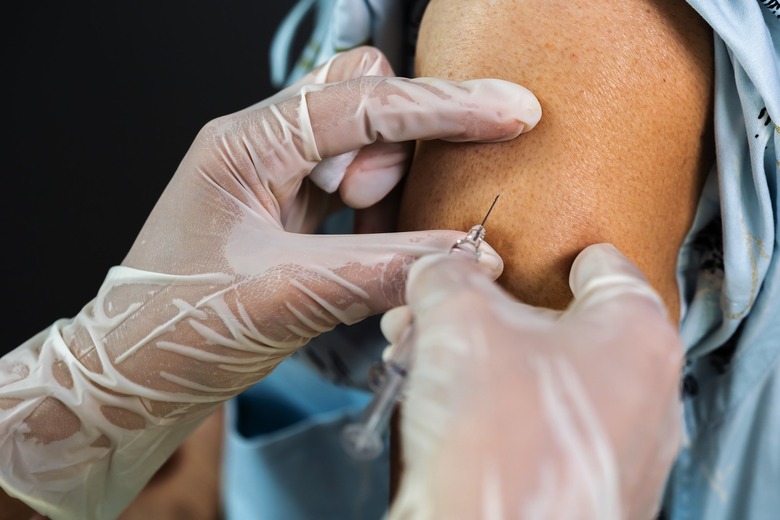Doctors Found A Weird New Coronavirus Vaccine Side Effect That Takes A Week To Appear
Several coronavirus vaccine candidates have been authorized for emergency use around the world. Most Western countries use a combination of Pfizer/BioNTech, Moderna, and AstraZeneca/Oxford vaccines. The Johnson & Johnson drug just cleared the regulatory review and will is also now available in various countries. On top of that, Russia and China are using their own vaccines and have exported their drugs to other markets. Nearly 276 million vaccine doses have been administered worldwide as of Thursday morning, with 58 million people having received the full two-shot regimen.
Several new studies have offered plenty of additional proof that the vaccines effectively prevent severe COVID-19 and deaths. The drugs are also well-tolerated, having mostly minimal side effects. The list of adverse reactions includes pain at the injection site and brief flu-like symptoms. An extremely low number of allergic reactions have also been seen from certain vaccines. And now, doctors have started to notice a weird new COVID-19 vaccine side effect that can take more than a week to appear in some people. Thankfully, it's extremely mild and isn't cause for concern at all.
The new symptoms appear several days after the second shot. The arm can turn red, sore, itchy, and swollen, The New York Times reports. The reaction seems to be harmless and should not be confused with an infection. A letter in The New England Journal of Medicine addresses the symptom, as observed in people who got the Moderna vaccine at Massachusetts General Hospital.
The letter details 12 cases of delayed skin reactions that appeared about 8 days after the first shot. The symptoms then disappeared about six days after the onset. The patients were advised to continue with the full treatment, and all of them completed the vaccination course. Three patients got a similar reaction after the second shot. But the skin lesions appeared faster, two days after the second jab, and lasted for up to three days after that.
Some of these delayed skin reactions included lesions measuring over 10 cm in diameter. Other patients experienced rashes in skin regions that were farther from the injection site, like the palm and the elbow. Some patients also experienced fatigue and muscle aches, which are expected side effects that have been associated with COVID-19 vaccines. The following set of photos shows the types of skin lesions that might appear:

Some patients were treated with antihistamines, others needed steroids, and one was prescribed an antibiotic by mistake.
The authors of the letter want to raise awareness of this type of side effect so that patients and doctors know such side effects are possible. The authors also advise against treatment with antibiotics to clear the skin issues:
Clinicians may not be prepared to address delayed local reactions to the [Moderna] mRNA-1273 vaccine. Given the scale-up of mass vaccination campaigns across the world, these reactions are likely to generate concerns among patients and requests for evaluation. These reactions have not been consistently recognized, guidance regarding the second dose of vaccine has varied, and many patients have unnecessarily received antibiotic agents. We hope this letter encourages additional reporting and communication regarding the epidemiologic characteristics, causes, and implications of these delayed cutaneous reactions, since this information might allay the concerns of patients, encourage completion of vaccination, and minimize the unnecessary use of antibiotic agents.
Dr. Kimberly Blumenthal, one of the authors of the letter, told The Times that these symptoms prompted the Massachusetts General Hospital to change the patient handout. "We had said it was normal to get redness, itching, and swelling when you get the vaccine," she said. "We changed the wording to say it can also start seven to 10 days after you get the vaccine." The allergy expert also said that she doesn't understand why the delayed skin reactions appeared only in patients who got the Moderna vaccine and not the BioNTech drug. Both are mRNA vaccines.
The Massachusetts General Hospital has created a registry to track patients with delayed skin reactions. Blumenthal said roughly 30 cases have been seen so far, and most of them are women.
Moderna did report delayed skin reactions after its Phase 3 trial, saying that 0.8% of volunteers experienced them after the first dose and 0.2% after the second jab. The NEJM letter points out that the Moderna trial did not fully characterize these delayed reactions. Here are the most common side effects of the Moderna vaccine, as listed by the FDA:
The most commonly reported side effects, which typically lasted several days, were pain at the injection site, tiredness, headache, muscle pain, chills, joint pain, swollen lymph nodes in the same arm as the injection, nausea and vomiting, and fever. Of note, more people experienced these side effects after the second dose than after the first dose, so it is important for vaccination providers and recipients to expect that there may be some side effects after either dose, but even more so after the second dose.
